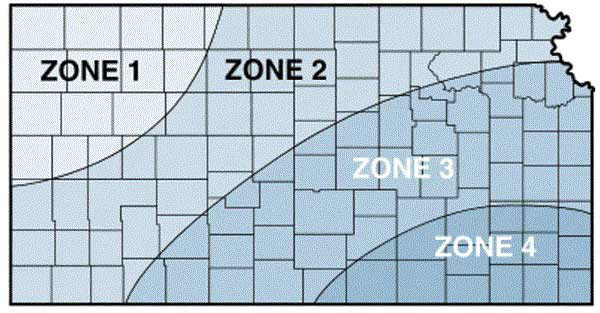September signals the Kansas State Fair, football games and, specifically for Kansas farmers, the kickoff of wheat planting season. While producers may be eyeing opportunities with moisture availability or to increase forage for a dual-purpose system, K-State experts cautioned producers not to start planting too early, lest their fields suffer from disease, insect and weed pressure from the very start of the growing season.
Depending on the year, earlier-planted or later-planted wheat may perform better or worse. Those results are driven by environmental conditions and disease pressure that are hard to predict at the start of the growing season. However, research-backed guidance for producers is readily available through K-State Research and Extension.
K-State recently posted the optimum wheat planting windows in Kansas by zone and other general guidance for producers in an Agronomy eUpdate. The update also details the potential risks of planting wheat too early, including increased risk of disease pressure, insect pests, weed infestations and undesirable growth of the crop.
“For planting too early, most of the concerns are related to some viral diseases that we have increased risks,” Lollato said, noting critters like wheat curl mites that transmit Wheat Streak Mosaic Virus (WSMV) or aphids that transmit Barley Yellow Dwarf (BYD) are more active earlier in the fall when the weather is warmer. In addition to disease transmission, other pests like armyworms are also more likely to cause direct damage to the crop when the weather remains warm.
Because of these active critters, controlling volunteer wheat that has emerged is an essential part of preparing for the upcoming planting season. K-State encourages wheat producers to terminate volunteer wheat at least two weeks prior to planting to allow enough time to kill all the disease-carrying wheat mites or aphids present in a field.
Beyond disease transmission, planting wheat too early can also have adverse consequences for the crop’s growth and development.
“Some varieties are what we call ‘temperature germination sensitive,’ meaning that if we’re planting in warm soils, they might not germinate until there’s a rain that comes and cools things down,” Lollato said. “And if we’re reaching for moisture and try to go deep, another concern of planting early is reduced coleoptile length.”
If the wheat plant is too far underground reaching for moisture, then the first true leaf might come up still underground, resulting in decreased emergence and poor stand establishment.
The final consequence of planting too early is a penalty on final grain yields due to excessive fall growth. For producers in a dual-purpose system where they plan on grazing wheat fields, planting earlier and having more biomass is a tempting proposition. But Lollato cautioned producers not to give in to this temptation too early as the increased biomass can use too much of the moisture profile too early, causing increased drought stress later on in the growing season.
“So many things can go wrong, even in the fall, so that the crop doesn’t get off to a good start,” Lollato said. “But, in an ideal scenario, you have had enough moisture for our volunteer to come up and have controlled the volunteer two weeks before planting, reducing our chances of WSMV, and we have had enough moisture for germination. And now in the fall with decent temperatures, we will have good root production and good tiller production for going into the winter with greater chances of reducing any potential harm from planting too early.”
Learn more about the latest planting recommendations and find your optimum planting window at kswheat.com/wheatrx. Wheat Rx is a series of Extension publications and other educational outreach designed to address key management areas of hard winter wheat. These publications contain recent data based on novel research funded in part by wheat farmers through the Kansas Wheat check-off.
_ _ _
Written by Julia Debes for Kansas Wheat



